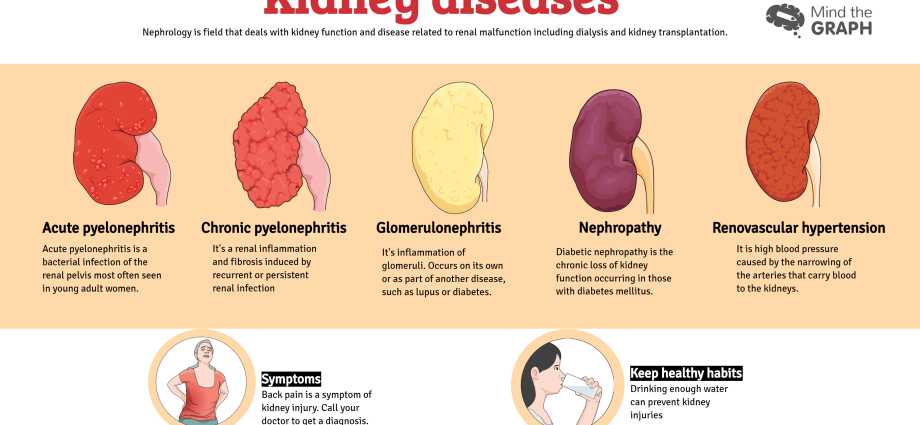Turinys
The kidneys play a major role in the urinary system. Any disease within this system, and also outside it, may endanger the kidneys. Kidney diseases can have serious consequences, so you need to react quickly when disturbing ailments appear. Find out more…
Shutterstock Žiūrėkite galeriją 10
- Ar turite sausus, suskilinėjusius kulnus? Kūnas bando jums pasakyti ką nors svarbaus
Įtrūkę kulnai yra daugelio iš mūsų problema. Mūsų pėdos patiria nuolatinį spaudimą, susijusį su viso kūno svorio nešimu. Nenuostabu, kad dėl nedidelio…
- Toksiškas oras Lenkijos rytuose. Ekspertas: tai degimo efektas, tik klausimas koks
Nuo antradienio rytiniuose Lenkijos regionuose oras rodo padidėjusį užterštumą. KD10 dulkių koncentracija viršijo pavojaus lygį. Vis dar ne…
- Skrandžio ir dvylikapirštės žarnos opos – simptomai, dieta, gydymas
Skrandžio opos sukelia labai nemalonius simptomus. Vargina rėmuo, vidurių pūtimas, pykinimas, netenka apetito, skauda pilvą? O gal jus persekioja vidurių užkietėjimas? Eiti į…
1/ 10 Cistitas
Cystitis is most often caused by bacterial infections. It manifests itself as a painful and frequent urge to urinate, accompanied by passing a small amount of urine. The symptoms may be accompanied by fever. The diagnosis of inflammation is based on the diagnosis of the symptoms described and the detection of inflammatory changes in the urine with significant bacteriuria. It is very important to effectively eliminate inflammation, preventing it from becoming chronic.
2/ 10 Hematuria
Hematuria, i.e. the presence of blood in the urine, is a very common symptom of diseases in the urinary system. The appearance of blood in the urine should therefore be treated as a disturbing symptom and try to determine the cause of any disorders. Blood in the urine may come from the kidneys or the urinary tract. The causes may include: traumatic damage to the urinary system, kidney stones, acute inflammation of the urinary system, kidney infarction, polyps or papillomas of the urinary bladder.
3/ 10 Šlapimo nelaikymas
Urinary incontinence is a fairly common ailment, most often affecting women over 45. It is characterized by the fact that urge to urinate occurs suddenly and cannot be waited out. The main types of this disease are stress urinary incontinence and urge incontinence. Stress urinary incontinence is the involuntary leakage of urine under the influence of exercise. Urge urinary incontinence, on the other hand, is the involuntary leakage of urine due to compulsive urge to urinate, due to sensory sensitivity of the bladder or unstable detrusor muscle. After diagnosing the actual cause, the doctor may choose conservative, pharmacological, or surgical treatment.
4/ 10 Urolitiazė
Kidney stones most often appear between the ages of 30 and 50. Its development is associated with the tendency to precipitate dissolved minerals or organic substances in urine. Mineral crystals stick together and form conglomerates of various sizes in the urinary tract. Small stones may be removed from the kidney with urine, while larger ones remain in the pelvis and lead to progressive damage to the kidney’s parenchyma due to urine stagnation and infection. Urolithiasis is most often manifested by severe, sharp pain in the lumbar region which radiates downwards towards the bladder, urethra and outer thigh.
5/ 10 Renal colic
Renal colic is characterized by paroxysmal, recurrent, very severe spasmodic pain in the smooth muscles of the urinary tract or, less frequently, of the bladder. Pain is caused by a sudden increase in urine pressure in the upper urinary tract. The pressure increase is caused by an obstruction in the outflow of urine from the renal pelvis.
6/ 10 Inflammation of the kidneys
There are two ways of inflammation of the kidneys. It can be so that it develops acutely, with rapidly progressive and spreading inflammation. As a consequence, it leads to the development of acute renal failure. In the latter case, the inflammatory process may develop slowly at first as chronic inflammation, which usually gradually impairs the function of the kidneys’ draining (cleansing). In the case of acute glomerulonephritis, usually after bacterial inflammation of the pharynx, for example, there are unexpectedly severe pain in the lumbar region, limited daily urine output and swelling of the upper body.
7/ 10 Nephrotic syndrome
As a consequence of inflammatory diseases, as a result of damage to the glomeruli and renal tubules, there is an increased loss of proteins together with the excreted urine (so-called proteinuria), with a secondary reduction in their concentration in blood serum. This condition, with its advancement, causes generalized swelling and permeation of free fluid into the body cavities. Nephrotic syndrome is therefore a set of symptoms that result from disease processes in the kidneys. Therefore, it can occur in the course of other systemic diseases that lead to an increase in kidney permeability.
8/ 10 Congenital kidney defects
One of the most common kidney malformations is duplication of the renal collecting system, usually bilateral, which is more common in women. It may happen that other diseases, sometimes affecting both kidneys, develop on the basis of this deformity. Other defects in the number of kidneys include its unilateral malformation or underdevelopment, or a very rare supernumerary kidney. The disadvantages may also be in the location of the organ. Its atypical location is called ectopy.
9/ 10 Podagra
Gout (gout) is a consequence of the genetically determined intra-organism increase in uric acid production. As a result of disorders, excess uric acid accumulates in the body, increasing its concentration in the blood. Uric acid deposits build up in the periarticular tissues, causing a painful, exudative inflammatory reaction. This is called gouty arthritis.
10/ 10 Cancer of the urinary tract
One of the most common cancers of the urinary tract are papillomas and bladder cancers. In some cases, they can also be located in the ureter or in the renal pelvis. Unfortunately, they are usually formed secretly and may develop asymptomatically for a long time. Symptoms that should raise suspicion include: hematuria, urolithiasis.










